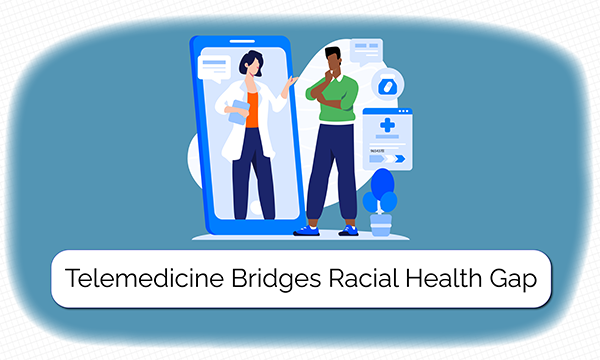Long-standing health inequities have plagued the US healthcare system for decades with Black and Hispanic patients not receiving the same quality of care or having easy access to healthcare services as their non-Black, predominantly White counterparts. With the onset of the pandemic, these inequities generally continued. Black patients also had a higher incidence of infection and mortality rates from poor living conditions and low vaccinations.
Telemedicine wins in primary care
A recent study indicates a small victory with the help of telemedicine as it seemingly bridges the racial health gap, at least, in primary care. Researchers from the University of Pennsylvania have discovered a dramatic increase in completed primary care appointments among Black patients, almost at par with non-Black patients. Though a small drop in a vast ocean this may seem, it bodes well for the future of telemedicine as having the potential to promote health equality and the prosperity of the general American patient population.
The findings of the Penn Med research solely focused on the usage of telemedicine by patients in need of primary care from 2019 to 2020 by looking into 1 million appointments each year. Data shows that Black patients who have completed primary care visits went up to more than 80% in 2020 from about 60% in the previous year. This rate equals non-Blacks’ who went from 70% to more than 80%, thereby closing the gap in primary healthcare access in Philadelphia, Pennsylvania through telemedicine.
This significant increase in telemedicine usage coincides with the time periods when the virtual service was well-established in the healthcare system. Black patients completed 33% of their appointments through telemedicine in 2020 while non-Black only saw a 25% completion.
The findings suggest that telemedicine has made it easy to obtain non-urgent primary care during the height of the pandemic when there were no vaccines yet. Despite the fears, primary care was still accessible by leveraging telemedicine solutions. In fact, a number of primary care practices survived the health crisis by providing virtual care services like Chronic Care Management and preventative care. While many medical offices were forced to shut down.
What the Penn Med study confirmed is that Black patients do not seem to have trouble using the technology or having access to it as initially assumed.
A glimpse on racial health disparities
The Center for Disease Control and Prevention (CDC) and the Office of Minority Health (OMH) of the US Department of Health and Human Services have recently looked into the health of the Black patient population with data that shows stark differences in health conditions and perceptions among Blacks and non-Blacks.
To just give a few examples, there are 13.8% of Black patients who believe they have fair or poor health compared to only 8.3% of non-Blacks. The number of overweight Black women is close to 80% compared to the 64.8% among non-Blacks. In 2017, 12.6% of Black children suffered from asthma while non-Blacks only had 7.78%. Of those suffering from hypertension, 42% are Black adults above 20 while only 28.7% among non-Blacks. The numbers suggest that Black patients have poorer health outcomes from poor behavior but also from disparities in economic, housing, and healthcare systems.
Another factor at play while Black patients do not often see their doctor is because of general mistrust. For instance, Black patients with chronic conditions who experienced delays in their diagnoses and treatments attest the reason to the color of their skin. Though not proven, it is indicative of the mistrust Black patients have with their doctors because of their cultural experience.
The future of telemedicine
Telemedicine appeals to consumers because it is easy, convenient, and inexpensive. A telemedicine visit would cost far less than an in-office visit would. Many patients with fewer resources would naturally prefer telemedicine because it allows them to access and obtain the care they need without the added expense of transportation, taking a day off from work, or dropping the kids at the daycare center.
It is actually the reduced cost of telemedicine that makes it appealing to people from low-income households especially when it comes to chronic care. By bridging the cost of care from costly to affordable, it could potentially bridge the racial health gap.
Telemedicine is an innovative way of delivering care, but it has the potential to do more like eliminating system-wide health disparities. Policymakers along with physicians, payers, and patients can further develop the role of telemedicine in promoting health equity where everyone, regardless of age and economic status, can attain their highest level of health.
Ascent Care Partners can help primary care physicians’ practice provide telemedicine solutions to provide better access to care, especially for chronic care patients. As a physician-led company, ACP understands the struggles of primary care providers and offers its turnkey Remote Patient Monitoring and Chronic Care Management solutions as a full service with no upfront cost, setup fee, risk, or increased overhead. ACP helps you be innovative in your care delivery while bringing in a new revenue stream to help practice stay independent and realize a deserved income.



